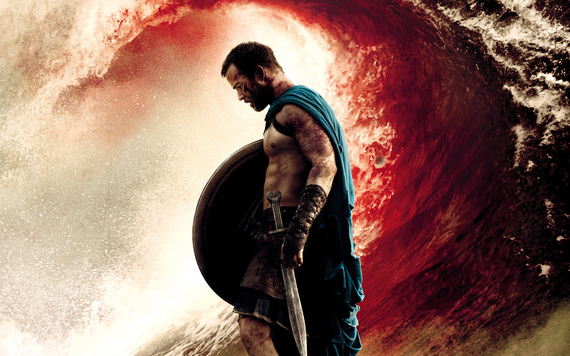The much-anticipated sequel to 300 has finally come to theaters, bringing with it a deluge of slow-mo kills, story, and naval tactics. As with any film, there are good and bad elements and as such, I find myself still walking the fence between Like/Dislike. Maybe this review will help me work that out; I invite you to tag along.
The Good
In my mind, story is life and life is character-driven. With any film, I look first for real characters, and then for the actions which fall naturally into the tale (war, relationships, etc.). If the movie is about these latter, ancillary things, the whole experience becomes a shallow exercise into concepts I already know. With Rise of Empires, the viewer gets the entire story. The Battle of Thermopylae (the subject of the first film) was one engagement in an otherwise long conflict, and this movie treats it as such. The viewer is told the tale of the war between Greece and Persia, all the way back to the Battle of Marathon. You will be shown a hero of Marathon, Themistocles, and learn a tragic story about a Queen named Artemisia (played by Eva Green, who does spectacular job). The background story leads the viewer through the different naval engagements of Greece and Persia while showing the path of each major character. In the end, the storyline comes full-circle and the viewer finds his or herself back at the beginning just in time for a climatic end. To summarize, you are given a full the full picture as shown by Zack Snyder. If story is life, then this element gives Rise its first star.
In addition to all of this, the fight scenes are well choreographed, the actors and actresses are superb, and the visual effects are beyond anything I expected. Themistocles fighting with the Queen's guard during the Battle of Salamis was one of the best fights I have ever seen in film and the soundtrack is incredible. There are many other great things about this movie but in the spirit of fairness, I would be remiss to exclude some of the concerns I had on my way to the 3D glasses bin after the show.
The Bad
If story is life, then it has to have some realism. If a man runs to a cliff, jumps, falls 300+ feet, and lands on the deck of a ship...his legs will break. If a man gets on a horse and tries to ride it across the decks of exploding ships through fire and water...he will get thrown off or killed in the process. If a man fights hard for longer than 10 minutes, wielding armor, a sword, and a shield...he will be completely exhausted (Greek or not). These things, coupled with gross historical inaccuracies, started to weigh on me by the second hour. The additional acrobatics and near-flight maneuvers reminded me of that other film where everything crouches and hides (I can't remember the name). Additionally, there seemed to be an element of trumping the first film with the slow-mo fight scenes. There was so much of it that the viewer gets bored, to the point where one person said on the way out, "Okay, I get it...they could fight well."
One last comment about "the bad" regarding this film is (sadly) the climax. All the aforementioned slow-mo sequences, choreographed fights, and basic badassery of the Greek army/navy inherently dilutes the impact of Spartan involvement. In the first film, we saw the grit and skill of the 300 Spartans as compared to the rest of the Greeks. In one scene, Leonidas asks some of the men in the other army about their professions with those men answering "potter" and "sculptor" only to have his men rouse a war cry when he asks them the same question. There was a clear separation in skill which inherently justified Spartan way of life for the viewer. In this film, these same potters and sculptors fight just as well as the Spartans, to the point that during the crucial moment at the Battle of Salamis when the Spartans arrive (otherwise known as the climax), the viewer sees it as something almost casual.
These elements, in addition to the unmentioned "sex" scene that went on for so long people were visually uncomfortable, make for a very difficult review. Though the film is entertaining and the storyline is good, the "bad" made the entire experience feel like an empty exercise. If asked for an official rating, I would give this film 2.5 Stars (out of 4).

